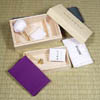Page 25
Method of Sword Maintenance part 1

The major purpose of sword care is to prevent the steel surface from oxidize or rust. It is necessary to thoroughly remove the stale oil and replace it entirely with new oil. The following describes the tools used and the order of operations of sword care.
1)Kiri wood box.
2) Mekugi-nuki: A tool to remove the bamboo peg (Mekugi) holding the blade in the hilt; usually made of brass or bamboo.
3) Uchiko: The most finely ground whetstone powder for cleaning the blade surface. First, wrapped in Japanese hand-made paper called Yoshino-gami, then wrapped by cotton or silk cloth, it comes through the wrapping materials when patted on the blade surface.
4)Abura-nuguishi: Paper used to spread oil over the blade surface.
5)Nugui-gami: High quality thick Japanese paper must be thoroughly wrinkled to soften and remove coarse and dusty elements for wiping the blade surface. There are two reasons for the wiping function
A)For preliminary removal of old oil
B)For removal of the powder.
6)Abura: A rust-preventive oil called Choji or Clove oil.
I) Lay down the mounted blade and push the peg out in preparation for removing the hilt.
II) Pull the blade out of the scabbard.
III) To remove the hilt, hold its end with the left hand on the side where the back of the blade is fit, and keep the blade in a slightly angled upright position. Use the right fist to hit the left wrist lightly a few times. When the tang (Nakago) becomes slightly loosened in the hilt, repeat until the tang comes out of the hilt by itself. When there is enough room to grasp the tang, the blade may be pulled out of the hilt by the right hand.
Be careful not to hit the left wrist too hard with the right hand as there is a danger that blades with short tangs like Tanto might bounce out of the hilt entirely. Therefore, the initial impact must be light, just to check how tightly the tang is fixed in the hilt. Then, the
|